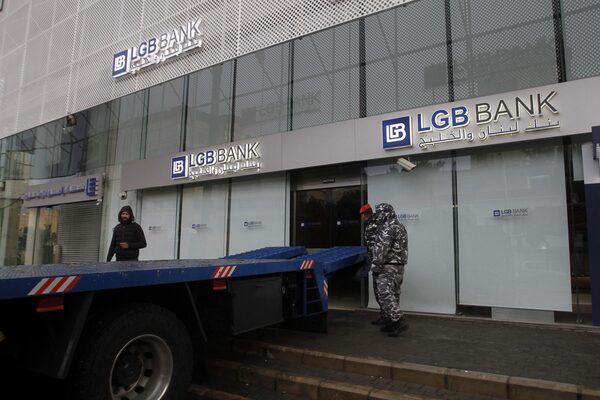
A flatbed truck, placed by an angry Lebanese client, blocks the entrance to his bank branch in the southern Lebanese city of Sidon on Jan. 4, 2020, after the establishment refused to allow him to withdraw his savings.MAHMOUD ZAYYAT/AFP/Getty Images
Lebanon sailed through the financial crisis. Now it’s lunging toward Greek status, and signs of a crisis are everywhere.
On Friday, a near-riot broke out in a bank branch in the northern Lebanese town of Halba when customers complained that they couldn’t withdraw cash. Lebanon is running short of U.S. dollars, and banks everywhere have restricted their supply and put arbitrary limits on the withdrawal of Lebanese pounds. Lebanon’s National News Agency reported a 10-hour standoff at the Halba bank. At one point, security forces fired tear gas into the building, and one customer was taken to hospital.
The good times in the Middle East’s favourite playground are over.
The cranes are idle in Beirut. Corruption is rampant – always has been. The banks are in crisis, and the debt-choked government, whose annual fiscal deficit is running at 10 per cent of GDP, is starved for cash. Mass anti-government protests since mid-October have paralyzed the main cities and forced the resignation of prime minister Saad Hariri and his cabinet. There is no economic salvation plan.
Adding to the gloom is the possibility of war between Iran and the United States. Tiny Lebanon, bordered by Syria and Israel and not far from Iraq, where a U.S. missile strike killed Iranian General Qassem Soleimani on Jan. 3, lives in a rough neighbourhood.
The Lebanese stock market is in the tank. A recession seems imminent. Ratings agency Fitch predicts a default on some US$88-billion of public debt. An IMF bailout may be in the works. Financial collapse, while unlikely, is not out of the question. That’s because Lebanon, where the Iran-backed Hezbollah party and militia are formidable forces, doesn’t have a lot of friends at the moment. On Sunday, Hezbollah leader Hassan Nasrallah called for attacks on U.S. military sites in the Middle East. Would U.S. President Donald Trump support an IMF bailout of Lebanon? Probably not.
“I’m very pessimistic about the economy,” Kamal Hamdan, an economist and executive director of Beirut’s Consultation and Research Institute, said in an interview.
How did Lebanon’s apparently resilient, largely open and buzzy entrepreneurial economy reach the cliff edge? The country is largely the author of its own misfortunes, even if the long Syrian Civil War on its border – Lebanon took in more than a million refugees – didn’t help. An economic model based on massive consumption and borrowing was always unsustainable. It just took a while for the proof to arrive.
Mr. Hamdan says the roots of the crisis go back to the era of Rafic Hariri, the wealthy businessman and father of Saad Hariri who was prime minister from 1992 to 1998 – the first post-civil war leader – and again from 2000 to 2004 (he was assassinated in 2005). He dropped the income tax rate to 10 per cent and went on a reconstruction borrowing spree. At the same time, warlords-turned-politicians bought votes by spending and hiring recklessly in their constituencies.
Public expenditures exploded. Between 1993 and 2018, the government of this tiny country spent some US$240-billion. But the vast majority of it went to current expenditures such as salaries, not capital expenditures that could have created economic efficiencies. The number of public servants rose fivefold to 300,000. Then, of course, taxes had to rise as deficits widened.
At the same time, foreign direct investment fell as the Syrian war raged on. Angered by the rise of Shia Hezbollah, wealthy Sunni Arabs from Saudi Arabia and the Gulf states stopped investing in Lebanon and even curtailed tourist visits. Recently, dollar remittances from Lebanese expats also slowed as faith in the banking sector waned.
In recent years, the government has tried to fund itself through a system dismissed as a Ponzi scheme by some economists. To maintain the Lebanese pound’s costly currency peg to the U.S. dollar, the central bank pushed up deposit rates to crazy levels – as much as 10 per cent. Those deposits, in turn, were loaned to the central bank.
In 2019, as the inflow of dollars dried up, the commercial banks introduced informal capital controls, limiting cash withdrawals. Businesses began to suffer from a credit squeeze. The mass riots that started in October and triggered the downfall of Mr. Hariri’s government were in good part motivated by the banking and economic crises. The currency peg is in trouble, and a dollar fetches 2,000 Lebanese pounds on the black market; the official rate is 1,500.
The new government will have to come up with a rescue plan fast – the cabinet is to be appointed this week. If it doesn’t, an IMF bailout of as much as US$25-billion may be needed. The wild card is a war between Iran and the U.S. that could shatter all the economies in the region. For Lebanon, the timing of Gen. Soleimani’s assassination could not have been worse.
Our Morning Update and Evening Update newsletters are written by Globe editors, giving you a concise summary of the day’s most important headlines. Sign up today.
 Eric Reguly
Eric Reguly